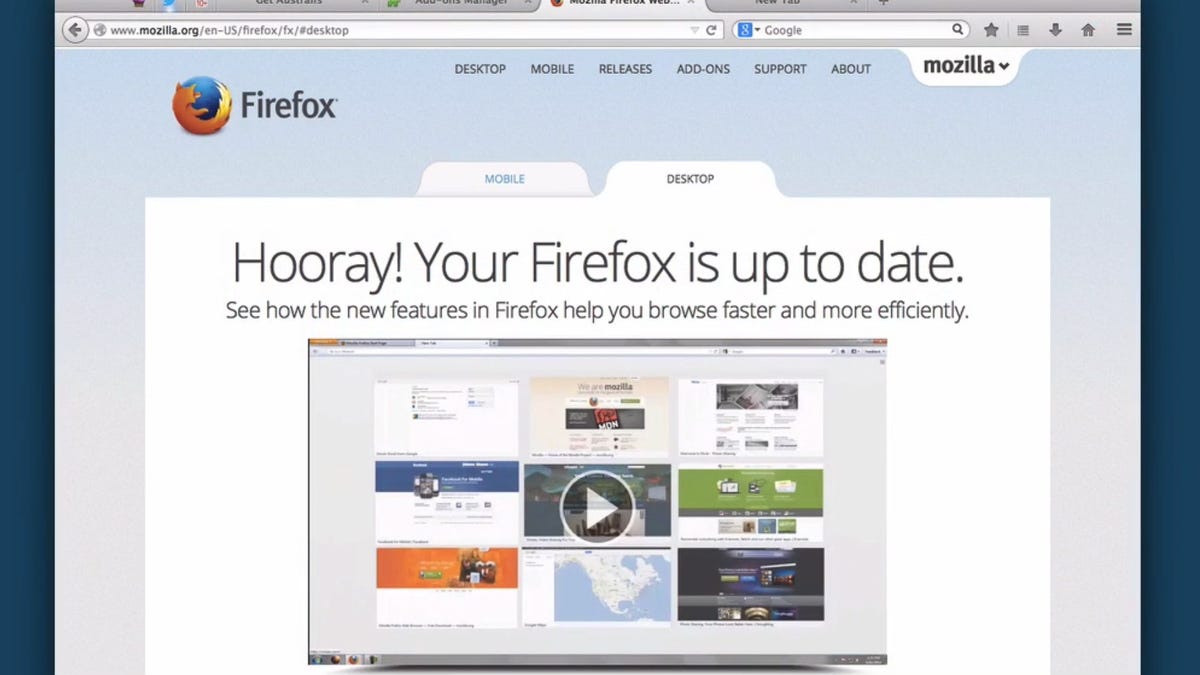Enter Australis: Mozilla streamlines Firefox's look
The new user interface is designed to be faster, easier to use, and suited for a future with Firefox running on phones and tablets, too. As always, though, change means pain.

Mozilla took a major step Monday to launch a significantly revamped look for Firefox, a project months in the making called Australis that will unify the browser's look across personal computers, tablets, and phones.
Australis brings a new look to the frame around the Web page: curvy tabs, more emphasis for the tab you're using and less for the ones you're not, and graphical menu that looks more like a grid of apps than a list of options.
Australis landed in the nightly version of Firefox for browser testers on Monday, taking its first step into regular testing and beginning the path that leads through the Aurora test version of the browser, then the Firefox beta, and last the final Firefox release. If all goes well, the first Firefox Nightly with Australis will arrive Tuesday, then Australis will arrive on PCs several weeks from now.
"It's a streamlining and simplification of the default interface, to declutter and better focus on how people use a browser today," said Madhava Enros, leader of the Firefox user experience design team, in a blog post Monday.
Johnathan Nightingale, vice president for Firefox, offered another reason to want the revamp in a separate blog post: "It's screaming fast, and it makes you faster, too."
A major interface change like Australis will be traumatic for some, just because it's change. Even if it's smart, anything that's different means millions of people will have to learn anew how to do things they previously understood.
But change is inevitable in the browser world, and Australis shouldn't be totally unfamiliar. Some earlier changes paved the way, such as the the collapsing of Firefox menu bar into a single menu button. And some changes are conceptually similar to what Microsoft has done with Internet Explorer and Google has done with Chrome.
If people don't like what they see, they can customize the Australis version of Firefox. For example, they'll be able to drag icons from the menu out into a toolbar area to the right of the browser tabs.
One thing that's not different is the dual address and search boxes. IE and Apple's Safari followed Chrome's lead in unifying these, but Mozilla has kept them separate, at least so far, even though typing a search query initiates a search.
Another expected set of difficulties will come from add-ons, which in Mozilla's case can customize the interface. When the interface changes, customizations can break.
Mozilla is working on a guide to Australis-related add-on changes for developers. According to the document, add-ons will have to reckon with changes to toolbars, buttons, status bars, and menus. Some of these complications are easier with the new Add-on SDK (formerly called Jetpack).
Themes, which can provide background graphics to Firefox, also will change
The mobile angle
Australis also carries over to the mobile domain, an important realm for Firefox as Mozilla tries hard to reproduce its PC influence in the fast-growing new market dominated by Apple and Google browsers today.
"You'll notice elements of Australis across all our platforms, mobile and desktop, as we try to have Firefox feel more like one product everywhere," Enros said in a video introduction to Australis.
Two elements of Australis already have arrived: First, a forward button that only appears when the mouse pointer hovers over the back button, and second, a download indicator in the toolbar that shows download progress.
And beyond the main changes now under way, Australis will lay the groundwork for changes to Firefox's start page and make the interface more flexible, Mozilla said.
All the change is worth it, Mozilla argues the advantages far outweigh the difficulties.
"We spend more time in our browsers than we do in our cars. Many of us log more hours in a browser than we do in our beds," Nightingale said. "For a tool you use that much, ergonomics matter; design matters; beauty matters."

